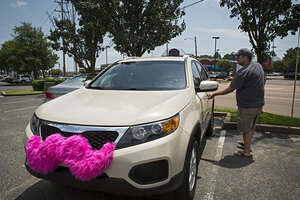Uber and Lyft move into the carpool lane with UberPool, Lyft Line apps
Uber and Lyft have occupied a grey area between individual car ownership and more traditional forms of public transportation like buses, taxis, and subways. Now, Uber and Lyft are expanding into the carpool lane.

Lyft driver Geoffrey Frischenters his vehicle before heading to the Memphis International Airport last month. Lyft and Uber have both launched services designed to attract the carpooling crowd.
Yolanda M. James/The Commercial Appeal/AP/File
What if you could reduce the number of vehicles on the road by using each one more efficiently?
By allowing travelers to rent individual rides, ridesharing services like Uber and Lyft have occupied a grey area between individual car ownership and more traditional forms of public transportation like buses, taxis, and subways.
Now, the companies are expanding from competing with taxis into a new arena: ride sharing. Which could bring them closer to competing with traditional public transport like buses.
Both Lyft and and Uber are launching services that will group riders along similar routes into the same car, New York Magazine reports.
Lyft recently acquired a company called Rover--a developer of real-time tracking software for vehicles--and the two have been working to launch Lyft Line, a service that puts people going in the same direction in the same car for a lower rate.
Users simply tap the "Line" button on the Lyft mobile app, and an algorithm matches them with other riders. The driver picks up to three riders up in order of proximity (wait time for the second and third riders is reduced to one minute to speed things up) and drops them off at their individual destinations.
Riders who choose this carpooling option will get a reduced rate, even if they end up riding alone. However, it will be even lower if other people do come along, while drivers will get the same cut of each fare as they do on solo trips.
Specific rates haven't been released, but Lyft says a trip normally costing $40 could cost as little as $20 or $25 with additional riders.
Carpooling
At the same time, competitor Uber announced a similar service called UberPool and it's also trying to lure carpoolers with reduced rates. The company claims its current service can save up to 40 percent over a taxi fare, and now says UberPool will offer an additional 40-percent savings on top of that.
Both services will start in San Francisco, and possibly expand to other cities. Lyft Line is already up and running, while UberPool launches this Friday, August 15.
Today, Uber and Lyft effectively offer an alternative to using your own vehicle for specific trips--offering an alternative to car ownership.
If these carpool services take off--with multiple passengers making multiple stops--ridesharing could start to look more like public transit than than the private car service it started as.
Whether users accept that new model will be tested over time, not to mention the ability of municipal governments to regulate such services.
But they offer the tantalizing possibility of putting more people into the same number ofcars. If LyftLine and UberPool eat away at public-transit usage, that could increase traffic.
On the other hand, if they take people out of their own cars who are willing to share rides with strangers--for a lower price than the traditional Uber fares--then the number of cars on the streets could fall, at least slightly.
Once more, apps emerge as the technology that disrupts existing business models--in this case, the centuries-old business of moving people to places for money.

